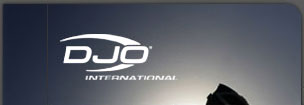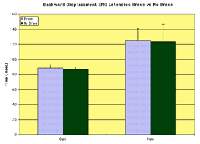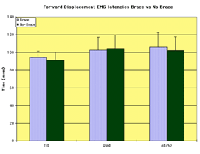Neuromuscular changes with use of the functional knee brace: a easure of reflex latencies and lower extremity EMG response.
By ML Voight, TA Blackburn Jr., J Kidder, DS Pflaster, LM Nashner
Introduction
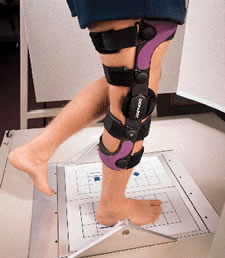 There is good subjective data showing ACL deficient and reconstructed patients have fewer episodes of giving way and feel more stable in a brace, while the clinical evidence indicates that knee bracing improves performance and reduces the risk of re-injury. The biomechanical and physiological mechanisms responsible for these observed clinical benefits, however, have never been adequately explained (1,2). Although the braces are designed to mechanically restrain abnormal knee motion, recent work has suggested that they may have neuromuscular effects as well (3,4). It is thought that the protective neuromuscular mechanism may be impaired by a loss or reduction of the proprioceptive inputs from the joint of the ACL injured knee (5,6,7,8). Thus, the knee brace may improve knee joint function by facilitating the proprioceptive neuromuscular response.
There is good subjective data showing ACL deficient and reconstructed patients have fewer episodes of giving way and feel more stable in a brace, while the clinical evidence indicates that knee bracing improves performance and reduces the risk of re-injury. The biomechanical and physiological mechanisms responsible for these observed clinical benefits, however, have never been adequately explained (1,2). Although the braces are designed to mechanically restrain abnormal knee motion, recent work has suggested that they may have neuromuscular effects as well (3,4). It is thought that the protective neuromuscular mechanism may be impaired by a loss or reduction of the proprioceptive inputs from the joint of the ACL injured knee (5,6,7,8). Thus, the knee brace may improve knee joint function by facilitating the proprioceptive neuromuscular response.
The goal of the study was to determine the effect of the functional knee brace on the protective proprioceptive reactions of freely standing subjects. The present study analyzed the proprioceptively mediated, automatic postural reactions of normal subjects freely standing on a single leg with and without a knee brace while exposed to brief, rapid support surface translations (9,10,11). The single leg design of the present study allowed comparisons between dominant and non-dominant legs and between the braced and unbraced conditions.
Methods
Subjects: Six subjects with normal knees agreed to participate in this study. The braces (DonJoy Legend™, Smith & Nephew, Inc.) were fitted according to the manufacturers strict guidelines by one physical therapist experienced in brace fitting. The dominant limb was identified by both questionnaire and having the subject kick a ball to the examiner.
Motor Control Testing: To examine the influence of the knee brace on proprioceptive protective mechanisms, subjects freely balanced on a single leg during exposure to sequences of abrupt, unexpected, forward and backward support surface translations (15.7 cm at 14.3 cm/sec for 0.4 sec followed 5 seconds later by a slow return to the starting position (EquiTest system, NeuroCom, International, Inc). A perturbation protocol consisting of 10 backward translations, 10 forward translations with the subjects facing forward, 10 forward translations with the subject facing 45 degrees medial, and 10 forward translations with the subject facing 45 degrees lateral was repeated 4 times with left and right leg stance and the knee unbraced and braced . The order of tests was randomized among subjects to minimize effects of practice.
Surface EMG Recording: Surface EMG reactions to the translations were recorded in medial gastrocnemius, medial and lateral quadriceps and hamstrings, hip abductors, and adductors using six individual remote amplifying bipolar metallic electrodes spaced 3 cm apart. EMG signals were sampled by digital computer (1000 per second) beginning 100 msec prior to the triggering of each surface displacement and continuing for 400 msec thereafter and then stored along with a digital shaft encoder signal indicating the onset of the support surface translation. This signal was used during off-line analysis to synchronize EMG recordings to the actual onset of surface movements.
Analysis of Latency and Amplitude: Response latencies and amplitudes to forward and backward translations were analyzed separately for each leg. Comparisons were made between the subjects' dominant and non-dominant legs and between the braced and unbraced conditions. For each group of ten trials, the EMG records of each muscle were ensemble averaged with the signals aligned in time to provide precise synchronization of translation onset times as indicated by the shaft encoder. The analysis of latency and amplitude properties was performed on the ensemble-averaged signals.
The response onset (latency) for each muscle was calculated by the computer based on the number of samples between the translation onset time and the position of an operator placed response onset marker. Individual onset markers were placed at the first point in time following translation onset at which the EMG signal rose above the maximum baseline level and remained above for a period of at least 25 msec. Response amplitude for each muscle was determined by integrating the area under the EMG curve (IEMG) for a fixed 150 msec interval beginning at the latency marker, and then subtracting an area equal to the pre-stimulus baseline EMG amplitude integrated for the equivalent 150 msec interval. This method of analysis focused on the automatic components of response rather than the later voluntary components.
Results
The patterns of stabilizing responses were similar to those reported previously for forward surface perturbations (9,10,11). No difference was detected in regards to limb dominance. During the unbraced trials, differences in latency between dominant and non-dominant limbs were less than 5 msec, and none were statistically significant (alpha > 0.1). The earliest EMG responses began in the tibialis anterior at 85-100 msec followed by quadriceps activation after a 10-30 msec additional delay.
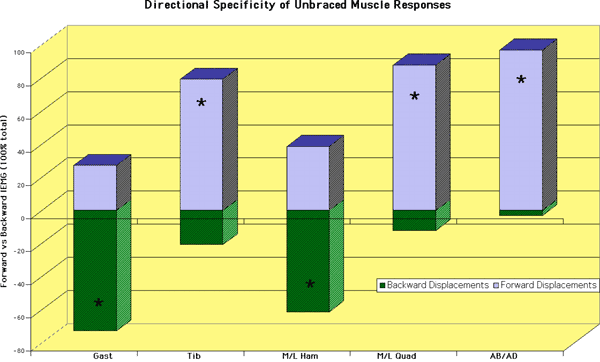 Directional Specificity of Muscle Responses in the Unbraced Condition: The responses of individual muscles tended to be directionally specific. Figure 1 compares for each muscle the IEMG amplitude of response to the forward and backward translations. Illustrated are results averaged across the twelve legs. IEMG amplitudes as a percent of the total elicited by the backward translations are shown below the zero axis, while percentages associated with the forward translations are shown above this axis. The tibialis anterior, quadriceps, and hip abductors/adductor were the primary muscles during reactions to the forward translations, while the gastrocnemius and hamstrings IEMG's were the primary muscles during responses to the backward translations.
Directional Specificity of Muscle Responses in the Unbraced Condition: The responses of individual muscles tended to be directionally specific. Figure 1 compares for each muscle the IEMG amplitude of response to the forward and backward translations. Illustrated are results averaged across the twelve legs. IEMG amplitudes as a percent of the total elicited by the backward translations are shown below the zero axis, while percentages associated with the forward translations are shown above this axis. The tibialis anterior, quadriceps, and hip abductors/adductor were the primary muscles during reactions to the forward translations, while the gastrocnemius and hamstrings IEMG's were the primary muscles during responses to the backward translations.
Muscle Response Latencies With and Without Knee Bracing: Differences in muscle response latencies for the twelve braced and unbraced legs are shown in Figure 2 for backward translations and in Figure 3 for the forward translations. Latencies ranging from 85-100 msec were observed in the ankle muscle stretched by translations; namely, the gastrocnemius during backward and the tibialis anterior during forward displacements. Latency differences between the unbraced and equivalent braced trials averaged less than 5 msec for all muscles, and none were statistically significant (alpha > 0.1).
IEMG Response Amplitudes With and Without Knee Bracing: Figure 4 illustrates differences in IEMG amplitudes during the braced trials compared to the equivalent unbraced trials, expressed as percentages of the unbraced trial IEMG's. Results show averages for the twelve legs. Statistically significant differences in IEMG (alpha < 0.05) are indicated by stars. The knee brace was associated with statistically significant increases in IEMG in the gastrocnemius and hip abductor/adductor muscles during the forward translations and in the quadriceps during the backward translations. The most dramatic influence of the brace was the 40% increase in the IEMG of the muscle functioning as lateral stabilizers of the knee joint, the hip adductors and abductors.
Discussion
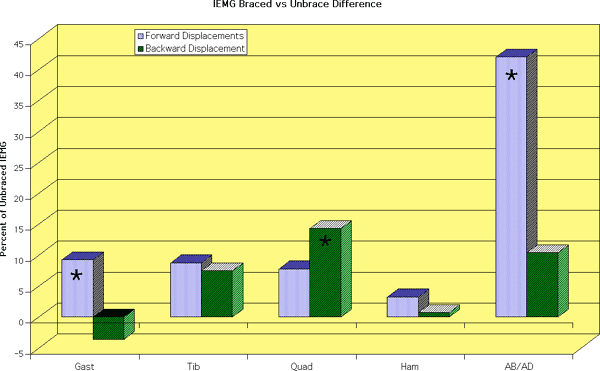
The brace had no effect on response latencies: We observed no significant differences in automatic reaction latencies between the unbraced and braced conditions. Furthermore, latencies observed in the present study were similar to those reported earlier with subjects exposed to surface translations during bilateral free standing (9,10,11). This finding is consistent with earlier literature indicating that automatic reactions are mediated by brainstem and cortical pathways and that latencies are a reflection of the conduction velocity of peripheral nerve and spinal pathways to and from the brain.
Knee bracing increased activity in antagonist and stabilizer but not the prime mover muscles: The knee brace caused significant increases in the amplitudes in three of the five muscle groups tested. In all instances of increased activity associated with the brace, the involved muscles were acting as either lateral joint stabilizers or antagonists to direction of movement. During reactions to forward displacements, hip abductors and adductors functioned as lateral stabilizers, while the increased gastrocnemius activity was in direct opposition to the tibialis anterior muscles, which functioned as a prime mover. Similarly, the increased quadriceps activity during the backward displacements was in direct opposition to the hamstrings, which functioned as a prime mover.
Functionally, the 10 - 40% increases in the response amplitudes of muscles acting as antagonists to the prime movers or as lateral stabilizers stiffen the joint. Thus, the modifications to automatic reactions associated with the knee brace appeared to contribute to enhanced knee (and ankle) joint stability. Future research is needed to determine whether the stabilizing influence of the knee brace can be replicated in the ACL deficient and ACL reconstructed knee and to determine the functional impact of this influence on actual daily life activities.
Presented at the 24th Annual American Orthopedic Society for Sports Medicine Meeting.
Vancouver, 1998.
References
1. Barrack RL, Skinner HB, Buckley SL: Proprioception in the anterior cruciate deficient knee. Am J Sports Med. 17: 1-6, 1989.
2. Beard DJ: Proprioception after rupture of the ACL: An objective indication of the need for surgery? JBJS. 75B: 311, 1993.
3. Wojtys EM, Loubert PV, Samson SY, et al: Use of a knee brace for control of tibial translation and rotation. JBJS 72A: 1323-1329, 1990.
4. Wojtys EM, Kothari SU, Huston LJ: Anterior cruciate ligament functional brace use in sports. Am J Sports Med: 24:539-546, 1996.
5. Borsa PA, Lephart SM, Irrgang JJ, et al: The effects of joint position and direction of joint motion on proprioceptive sensibility in anterior cruciate ligament deficient athletes. Am J Sports Med: 25: 336- 340, 1997.
6. Lephart SM, Pincivero DM, Giraldo JL, Fu FH: The role of proprioception in the management and rehabilitation of athletic injuries. Am J Sports Med: 25:130-137, 1997.
7. Lephart SM, Kocher MS, Fu FH, et al: Proprioception following anterior cruciate ligament reconstruction. J Sport Rehab: 1: 186-196, 1992.
8. Voight ML, Cook G, Blackburn TA: Functional lower quarter exercise through reactive neuromuscular training. In: Current trends for the rehabilitation of the athlete. Bandy WD(ed), SPTS Home Study Course. Lacrosse, WI, 1997.
9. Diener HC, Horak FB, Nashner LM. (1988). Influence of stimulus parameters on human postural responses. J Neurophysiol 59: 1888-1905.
10. Horak FB, Nashner LM. (1986). Central programming of postural movements: adaptation to altered support-surface configurations. J Neurophysiol 55: 1369-1381.
11. Nashner LM, McCollum G. (1985). The organization of human postural movements: a formal basis and experimental synthesis. Behav Brain Sci 8: 135-172.
